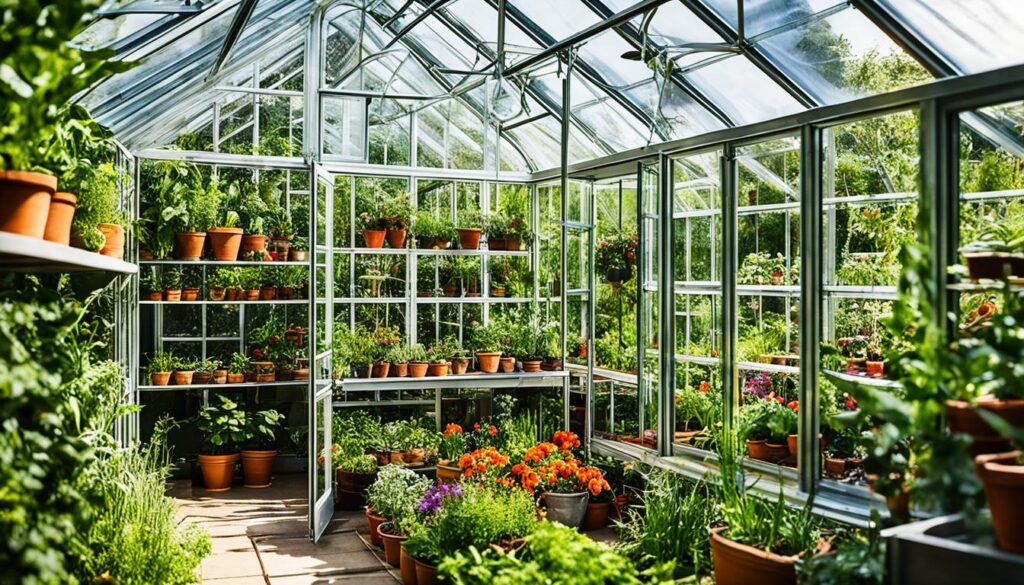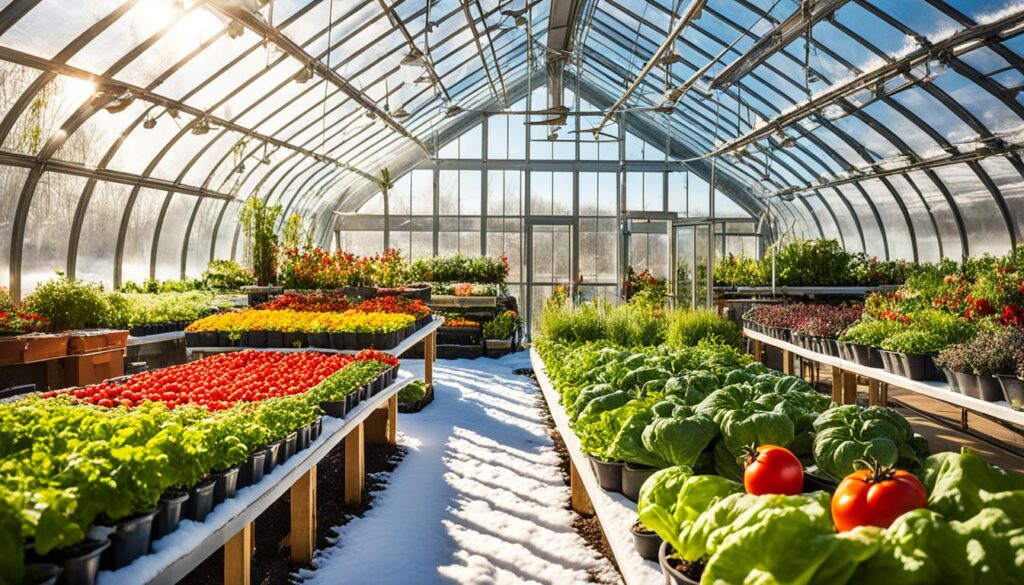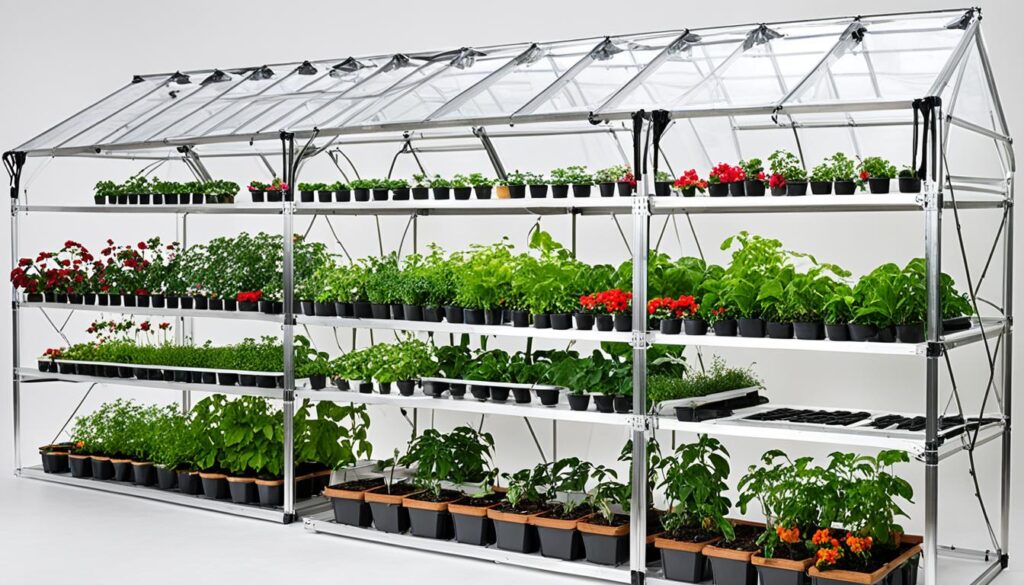Welcome to your ultimate guide on greenhouses and indoor gardening. Here, you’ll learn how a greenhouse can make your gardening amazing. You’ll see the different types of kits and how to keep your garden perfect all year.
Discover the perks of greenhouse gardening and get tips for your plants. With the right setup and care, you can grow many plants indoors. Let’s start this journey to indoor gardening mastery together.
What is a Greenhouse?
A greenhouse is a special structure made for plants. It has walls of glass or plastic that let sunlight in but keep heat inside. This makes a perfect place for plants to grow, no matter the weather outside.
Greenhouses come in all sizes, from small for home gardens to big for farms. They all aim to create the best spot for indoor gardening. You can grow everything from pretty flowers to tasty veggies inside them.

Greenhouses are more than just pretty buildings. They are key to growing food in a green way. Thanks to new designs and tech, greenhouses can control light, heat, and moisture. This helps plants grow all year, making food available to everyone.
Benefits of Greenhouse Gardening
Greenhouse gardening brings many advantages that change how you garden. One big plus is growing plants all year, no matter the weather outside. This lets you grow a wide variety of plants that might not do well in your area.
Greenhouses keep plants safe from bad weather. They protect against wind, rain, and extreme temperatures. This helps plants grow better and leads to healthier crops. For example, in Almería, Spain, greenhouses help farmers grow a lot of fruits and vegetables every year.
Greenhouses also make it easier to control pests. You can use natural ways to fight pests and diseases. This means healthier plants and more food.
New technologies make greenhouses better for the planet. In Switzerland, new methods use half as much thermal energy. Products like Brite Solar can cut down on water use by 20% to 40%. This makes gardening more eco-friendly.
To sum up, greenhouses offer many benefits. You can garden all year, protect your plants, manage pests, and be more sustainable. It’s a great choice for gardeners who care about the planet.

Selecting the Right Greenhouse Kit
Choosing the right greenhouse kit is key for a successful indoor garden. There are many options that can change your gardening experience. They help plants grow well. Think about what your plants need and how much space you have.
Types of Greenhouse Kits Available
There are many greenhouse kits out there, each for different needs. Here are some common ones:
- Freestanding Greenhouses: These give lots of space and can go anywhere in your yard.
- Lean-To Greenhouses: These attach to a building and are great for small spaces.
- Hoop Houses: These are easy on the wallet and versatile, using PVC or metal hoops with plastic.
- Gable Greenhouses: They have a peaked roof for good air flow and look nice.
Size and Space Considerations
Think about your gardening space when picking a greenhouse kit. Look at the area you have and think about these things:
- Available Land: Measure your outdoor space to see what size greenhouse fits.
- Plant Variety: Different plants need different space for growth. Keep this in mind.
- Future Expansion: If you want to grow more, choose a bigger greenhouse.
Look at your options and see which greenhouse type fits your garden needs. This can help you have a great indoor garden. Whether you want to grow herbs or vegetables, the right greenhouse can make a big difference.

| Greenhouse Type | Ideal for | Space Requirement |
|---|---|---|
| Freestanding | Large gardens | Minimum 10×10 feet |
| Lean-To | Small gardens | 4×8 feet or larger |
| Hoop House | Budget-friendly options | 10×20 feet or more |
| Gable | Aesthetic appeal | 8×10 feet minimum |
DIY Greenhouses: Building Your Indoor Garden
Building a DIY greenhouse can make your indoor gardening better. With the right plans, you can make a space that fits your needs. Whether you’re new to gardening or have lots of experience, there are plans for all skill levels and garden sizes.
Essential Greenhouse Plans to Consider
Think about these popular designs for your DIY greenhouse:
- Lean-to Greenhouse: Great for small areas, it leans against a wall to get lots of sunlight.
- Freestanding Greenhouse: You can put these anywhere in your yard.
- Hoop House: A budget-friendly choice, it uses plastic sheeting for a light framework.
Greenhouse Materials for Durability
Choosing the right materials is key for a long-lasting greenhouse. Here’s a look at some common materials:
| Material | Pros | Cons |
|---|---|---|
| Polycarbonate | Durable and UV-resistant | More expensive than plastic |
| Glass | Transmits light well | Heavy and can break |
| Plastic Sheeting | Light and cheap | Not as durable, may need to be replaced often |
Greenhouse Construction Techniques
Building a greenhouse needs careful planning for it to last long and work well. Start with foundation preparation. A strong base is key for your greenhouse’s life. Think about the soil type and how water moves through it to prevent problems later.
Then, you move on to framing. Use strong stuff like wood or metal for a solid structure. The type of material you pick affects your greenhouse’s strength and how stable it is. When picking what covers your greenhouse, make sure it’s securely fastened. You can use polycarbonate panels or greenhouse films. These give different levels of insulation and let in different amounts of light, which plants need.
After setting up the base and frame, focus on making it last longer. Check your greenhouse often for any damage, especially after bad weather. Keeping up with maintenance helps it last longer and keeps your plants safe. This lets your plants grow well as you enjoy gardening inside.
If you want to learn more, check out detailed guides on indoor gardening. Find out which plants are best and how to keep your greenhouse healthy. This will make your greenhouse better at what it does.
Climate-Controlled Greenhouses: Maintaining Optimal Conditions
A climate-controlled greenhouse is key for plant growth, no matter the weather outside. With the right heating and humidity control, your plants can thrive. This makes them grow better.
Heating and Cooling Solutions
For the right temperature in your greenhouse, look at different heating options. Electric heaters control the temperature well, and propane heaters work great in big areas. Thermal mass systems are good too. They hold heat during the day and slowly release it at night, keeping it warm.
To keep the heat from getting too high, use cooling methods like exhaust fans or shading. This stops your plants from getting too stressed by the heat.
Humidity Control Methods
Keeping the right humidity in your greenhouse is also important. Too much humidity can cause mold and disease, while too little can stress plants. Ventilation systems help keep air moving and keep humidity right.
Dehumidifiers also help by taking out extra moisture. These tools work together to keep the air balanced. This helps your plants stay healthy.
| Heating Solutions | Description | Advantages |
|---|---|---|
| Electric Heaters | Provides direct heat with temperature settings | Precise control and easy installation |
| Propane Heaters | Efficient for larger greenhouse spaces | Cost-effective and quick heating |
| Thermal Mass Systems | Stores and releases heat gradually | Energy-efficient and reduces temperature fluctuations |
| Humidity Control Methods | Description | Benefits |
|---|---|---|
| Ventilation Systems | Circulates air to maintain humidity | Reduces disease risk and promotes healthy plant growth |
| Dehumidifiers | Removes excess moisture from the air | Stabilizes humidity levels |
Must-Have Gardening Supplies for Your Greenhouse
Getting the right gardening supplies is key to a successful indoor garden. This guide will show you the must-have tools and equipment for your greenhouse. You’ll learn about the tools you need for efficiency and how to pick the best fertilizers for your plants.
Essential Tools and Equipment
Having the right tools makes gardening better. Here are some important items:
- LED grow lights – These give plants the best light for growing.
- Watering systems – These keep the soil moist all the time.
- Propagation kits – Perfect for starting seeds and cuttings.
- Thermometers and hygrometers – These help you keep an eye on temperature and humidity.
- Pruning shears – Needed for trimming plants to keep them healthy.
Choosing the Right Fertilizers
Picking the right fertilizers is key for healthy plants. Here are some options:
| Fertilizer Type | Best For | Application Method |
|---|---|---|
| Organic Fertilizers | Vegetables and herbs | Mix into soil or top-dress |
| Chemical Fertilizers | Flowers and high-yield crops | Water-soluble or granules |
| Slow-Release Fertilizers | Plants that need steady nutrients | Put into soil when planting |
Knowing what your plants need is important for success. With the right gardening supplies and fertilizers, your indoor garden will thrive.
Common Challenges in Greenhouse Gardening
Greenhouse gardening has many benefits but also some challenges. You might face problems like pests and tricky watering. Knowing these challenges can help you find ways to beat them and make your plants grow well.
Pest Control Solutions
Keeping pests away is key to a healthy greenhouse. If pests aren’t controlled, they can destroy your crops. There are many ways to deal with pests, depending on the situation.
Using good bugs like ladybugs and mites can help control pests. For tough pests, you might need to use chemicals. It’s best to pick the safest and most effective options.
Avoiding Overwatering and Underwatering
Watering your plants right is crucial for their health. Too much water can cause root rot, while too little can stress them out. To get it right, set a regular watering schedule based on your plants’ needs.
Smart watering systems and moisture sensors can help give your plants just the right amount of water. Checking the soil often helps you avoid watering too much or too little. This keeps your plants healthy and your gardening successful.
Places like Local Bounti use the latest tech to water plants well and save resources. They’re working with Sam’s Club to improve their watering and save more resources. You can read more about their efforts here.
Maximizing Your Greenhouse Space
Using your greenhouse space well is key for great indoor gardening. With smart strategies, you can grow more plants and keep them easy to reach and maintain. This part talks about vertical gardening and the best plants for small spaces. It helps you use your greenhouse space better.
Vertical Gardening Techniques
Vertical gardening is a smart way to make your greenhouse better. It lets you grow more plants without taking up a lot of floor space. Here are some good ways to do it:
- Shelving Units: Put up strong shelves for containers at different heights. This gives you space below for more plants.
- Wall Planters: Use special planters that stick to walls. They let you grow herbs, flowers, and small veggies without using ground space.
- Hanging Baskets: Hang baskets from the ceiling or beams. This is great for plants that spread out and uses vertical space well.
- Vertical Trellises: Put trellises in the greenhouse for plants that climb like tomatoes and cucumbers. It helps with air flow and saves ground space.
Best Plant Choices for Limited Space
Choosing the right plants for vertical gardening is important when you have little space. Some plants do well in small areas and give a lot of produce. Here are some good ones:
- Blueberries: These are popular in the U.S. and can produce from early summer to late fall. Highbush types work well in pots and small spaces.
- Alocasia Varieties: Plants like Alocasia ‘Black Ruffle’ and ‘Borneo Giant’ look nice and do well in small spots with the right care.
- Tomatoes: Compact tomatoes grow well in pots and can be supported with stakes. This helps them grow healthy without spreading out.
- Peppers: Sweet and hot peppers that save space are great for vertical growth. They can be easily supported as they grow.
By using these vertical gardening methods and picking the right plants, you can make the most of your greenhouse space. This makes gardening more fun and lets you grow more, making the best use of your green space.
Maintaining Your Greenhouse for Success
Keeping your greenhouse in good shape is key for successful gardening. It helps plants grow well and keeps pests and diseases away. Important steps include cleaning the glass or plastic to let in more sunlight, checking for damage, and making sure vents work right.
Here are some important tips for indoor gardening:
- Clean surfaces often to stop algae and mold from growing.
- Look for cracks or breaks that can mess with temperature and humidity.
- Test heating and cooling systems before each season to make sure they work.
- Check irrigation systems for leaks or blockages to keep moisture levels right.
- Take out dead or sick plants quickly to stop pests and diseases from spreading.
Getting ready for the end of the season is also crucial. Here’s what to do:
- Clear out old crops to make room for new ones.
- Clean tools and pots to keep things disease-free.
- Put away any delicate items to protect them from harsh weather.
- Fix any damage to the structure to get ready for the next season.
Knowing what to do each season helps keep your indoor garden healthy and thriving all year. By following these steps, you set the stage for ongoing success in your greenhouse.
Seasonal Tips for Year-Round Greenhouse Gardening
To make the most of your greenhouse, adjust your gardening with the seasons. Learn how to switch up your plants for year-round growth. Start by making a plan that looks at temperature and light changes inside your greenhouse. These things really affect how plants grow.
In spring and summer, grow many types of plants like fruits and flowers. For fall and winter, plant root veggies or herbs that like cooler weather. Also, have a plan for pests or sudden cold snaps. Using the right climate control keeps your greenhouse perfect for gardening.
Keep track of which plants do well in each season. By understanding your greenhouse’s climate, you can grow a great indoor garden. With these tips and an eye on the environment, your greenhouse can give you fresh produce all year.



